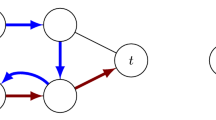Abstract
In this paper, we investigate three strategies of how to use a spanning tree T of a graph G to navigate in G, i.e., to move from a current vertex x towards a destination vertex y via a path that is close to optimal. In each strategy, each vertex v has full knowledge of its neighborhood N G [v] in G (or, k-neighborhood D k (v,G), where k is a small integer) and uses a small piece of global information from spanning tree T (e.g., distance or ancestry information in T), available locally at v, to navigate in G. We investigate advantages and limitations of these strategies on particular families of graphs such as graphs with locally connected spanning trees, graphs with bounded length of largest induced cycle, graphs with bounded tree-length, graphs with bounded hyperbolicity. For most of these families of graphs, the ancestry information from a BFS-tree guarantees short enough routing paths. In many cases, the obtained results are optimal up to a constant factor.
Preview
Unable to display preview. Download preview PDF.
Similar content being viewed by others
References
Bose, P., Morin, P., Stojmenovic, I., Urrutia, J.: Routing with guaranteed delivery in ad hoc wireless networks. In: 3rd International Workshop on Discrete Algorithms and Methods for Mobile Computing and Communic., pp. 48–55. ACM Press, New York (1999)
Brandstädt, A., Dragan, F.F., Chepoi, V.D., Voloshin, V.I.: Dually chordal graphs. SIAM J. Discrete Math. 11, 437–455 (1998)
Brandstädt, A., Bang Le, V., Spinrad, J.P.: Graph Classes: A Survey, Philadelphia. SIAM Monographs on Discrete Mathematics and Applications (1999)
Chepoi, V., Dragan, F.F., Estellon, B., Habib, M., Vaxès, Y.: Diameters, centers, and approximating trees of δ-hyperbolic geodesic spaces and graphs. In: SoCG 2008, pp. 59–68 (2008)
Dourisboure, Y., Gavoille, C.: Tree-decompositions with bags of small diameter. Discrete Mathematics 307, 2008–2029 (2007)
Dragan, F.F., Matamala, M.: Navigating in a graph by aid of its spanning tree. In: Hong, S.-H., Nagamochi, H., Fukunaga, T. (eds.) ISAAC 2008. LNCS, vol. 5369, pp. 788–799. Springer, Heidelberg (2008)
Dragan, F.F., Xiang, Y.: How to use spanning trees to navigate in graphs, full version, http://www.cs.kent.edu/~dragan/MFCS2009-journal.pdf
Fonseca, R., Ratnasamy, S., Zhao, J., Ee, C.T., Culler, D., Shenker, S., Stoica, I.: Beacon vector routing: Scalable point-to-point routing in wireless sensornets. In: 2nd USENIX/ACM Symp. on Networked Systems Design and Implementation (2005)
Fraigniaud, P.: Small Worlds as Navigable Augmented Networks: Model, Analysis, and Validation. In: Arge, L., Hoffmann, M., Welzl, E. (eds.) ESA 2007. LNCS, vol. 4698, pp. 2–11. Springer, Heidelberg (2007)
Fraigniaud, P., Korman, A., Lebhar, E.: Local MST computation with short advice. In: SPAA 2007, 154–160 (2007)
Garg, V.K., Agarwal, A.: Distributed maintenance of a spanning tree using labeled tree encoding. In: Cunha, J.C., Medeiros, P.D. (eds.) Euro-Par 2005. LNCS, vol. 3648, pp. 606–616. Springer, Heidelberg (2005)
Gartner, F.C.: A Survey of Self-Stabilizing Spanning-Tree Construction Algorithms, Technical Report IC/2003/38, Swiss Federal Institute of Technology (EPFL) (2003)
Gavoille, C.: Routing in distributed networks: Overview and open problems. ACM SIGACT News - Distributed Computing Column 32 (2001)
Gavoille, C., Peleg, D., Pérennès, S., Raz, R.: Distance labeling in graphs. J. Algorithms 53, 85–112 (2004)
Giordano, S., Stojmenovic, I.: Position based routing algorithms for ad hoc networks: A taxonomy. In: Ad Hoc Wireless Networking, pp. 103–136. Kluwer, Dordrecht (2004)
Gromov, M.: Hyperbolic Groups. In: Gersten, S.M. (ed.) Essays in group theory. MSRI Series, vol. 8, pp. 75–263 (1987)
Holm, J., de Lichtenberg, K., Thorup, M.: Poly-logarithmic deterministic fully-dynamic algorithms for connectivity, minimum spanning tree, 2-edge, and biconnectivity. J. ACM 48(4), 723–760 (2001)
Jacquet, P., Viennot, L.: Remote spanners: what to know beyond neighbors. In: IPDPS 2009, pp. 1–15 (2009)
Karp, B., Kung, H.T.: GPSR: greedy perimeter stateless routing for wireless networks. In: 6th ACM/IEEE MobiCom., pp. 243–254. ACM Press, New York (2000)
Kleinberg, J.M.: The small-world phenomenon: an algorithm perspective. In: STOC 2000, pp. 163–170. ACM, New York (2000)
Kleinberg, R.: Geographic routing using hyperbolic space. In: INFOCOM 2007, pp. 1902–1909 (2007)
Kuhn, F., Wattenhofer, R., Zhang, Y., Zollinger, A.: Geometric ad-hoc routing: of theory and practice. In: PODC, pp. 63–72. ACM, New York (2003)
Liben-Nowell, D., Novak, J., Kumar, R., Raghavan, P., Tomkins, A.: Geographic routing in social networks. PNAS 102, 11623–11628 (2005)
Linial, N., London, E., Rabinovich, Y.: The Geometry of Graphs and Some of its Algorithmic Applications. Combinatorica 15, 215–245 (1995)
Peleg, D.: Proximity-Preserving Labeling Schemes and Their Applications. J. of Graph Theory 33, 167–176 (2000)
Peleg, D.: Distributed Computing: A Locality-Sensitive Approach. SIAM Monographs on Discrete Math. Appl. SIAM, Philadelphia (2000)
Rao, A., Papadimitriou, C., Shenker, S., Stoica, I.: Geographical routing without location information. In: Proceedings of MobiCom 2003, pp. 96–108 (2003)
Robertson, N., Seymour, P.D.: Graph minors. II. Algorithmic aspects of tree-width. Journal of Algorithms 7, 309–322 (1986)
Santoro, N., Khatib, R.: Labelling and Implicit Routing in Networks. The Computer Journal 28(1), 5–8 (1985)
Shavitt, Y., Tankel, T.: On internet embedding in hyperbolic spaces for overlay construction and distance estimation. In: INFOCOM 2004 (2004)
Thorup, M., Zwick, U.: Compact routing schemes. In: 13th Ann. ACM Symp. on Par. Alg. and Arch., July 2001, pp. 1–10 (2001)
Author information
Authors and Affiliations
Editor information
Editors and Affiliations
Rights and permissions
Copyright information
© 2009 Springer-Verlag Berlin Heidelberg
About this paper
Cite this paper
Dragan, F.F., Xiang, Y. (2009). How to Use Spanning Trees to Navigate in Graphs. In: Královič, R., Niwiński, D. (eds) Mathematical Foundations of Computer Science 2009. MFCS 2009. Lecture Notes in Computer Science, vol 5734. Springer, Berlin, Heidelberg. https://doi.org/10.1007/978-3-642-03816-7_25
Download citation
DOI: https://doi.org/10.1007/978-3-642-03816-7_25
Publisher Name: Springer, Berlin, Heidelberg
Print ISBN: 978-3-642-03815-0
Online ISBN: 978-3-642-03816-7
eBook Packages: Computer ScienceComputer Science (R0)




